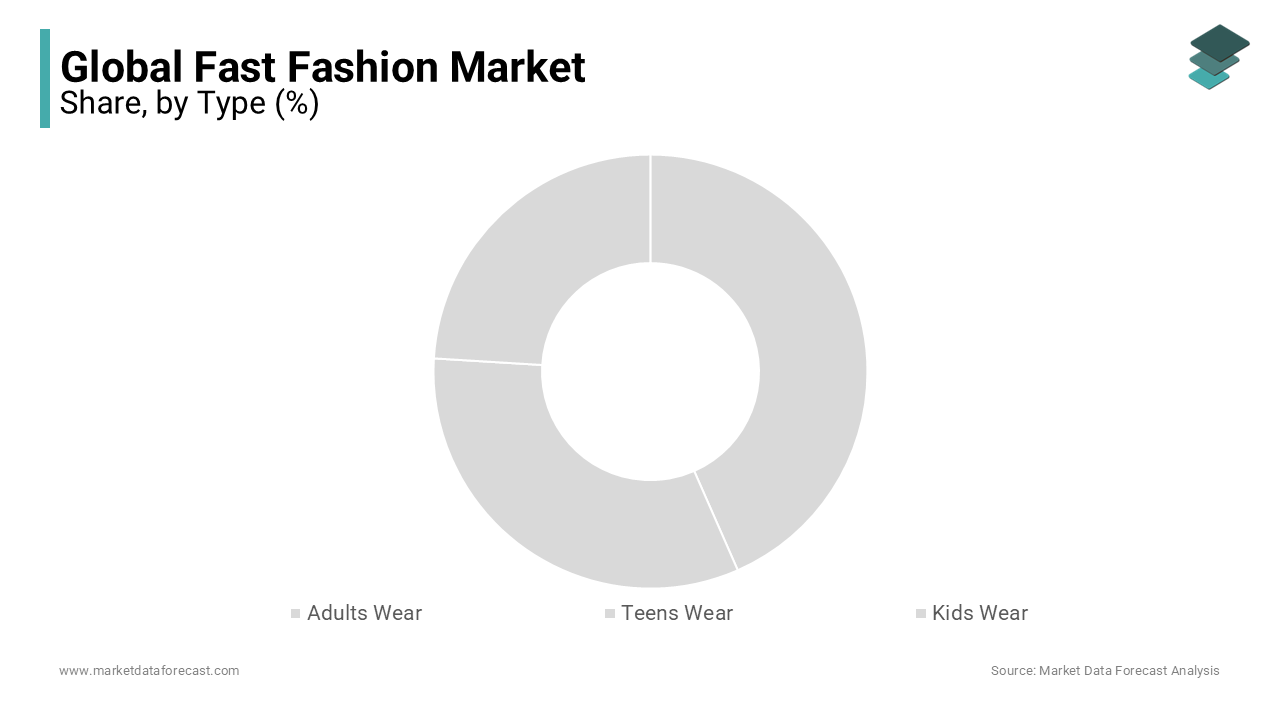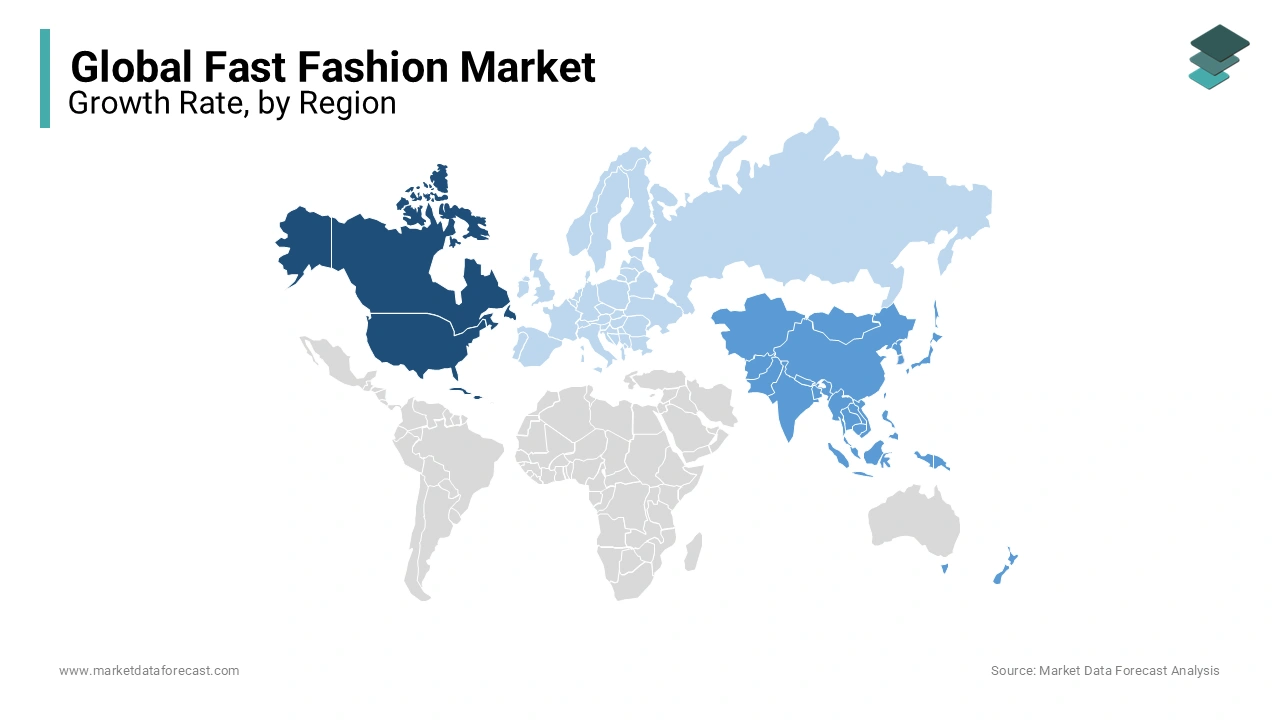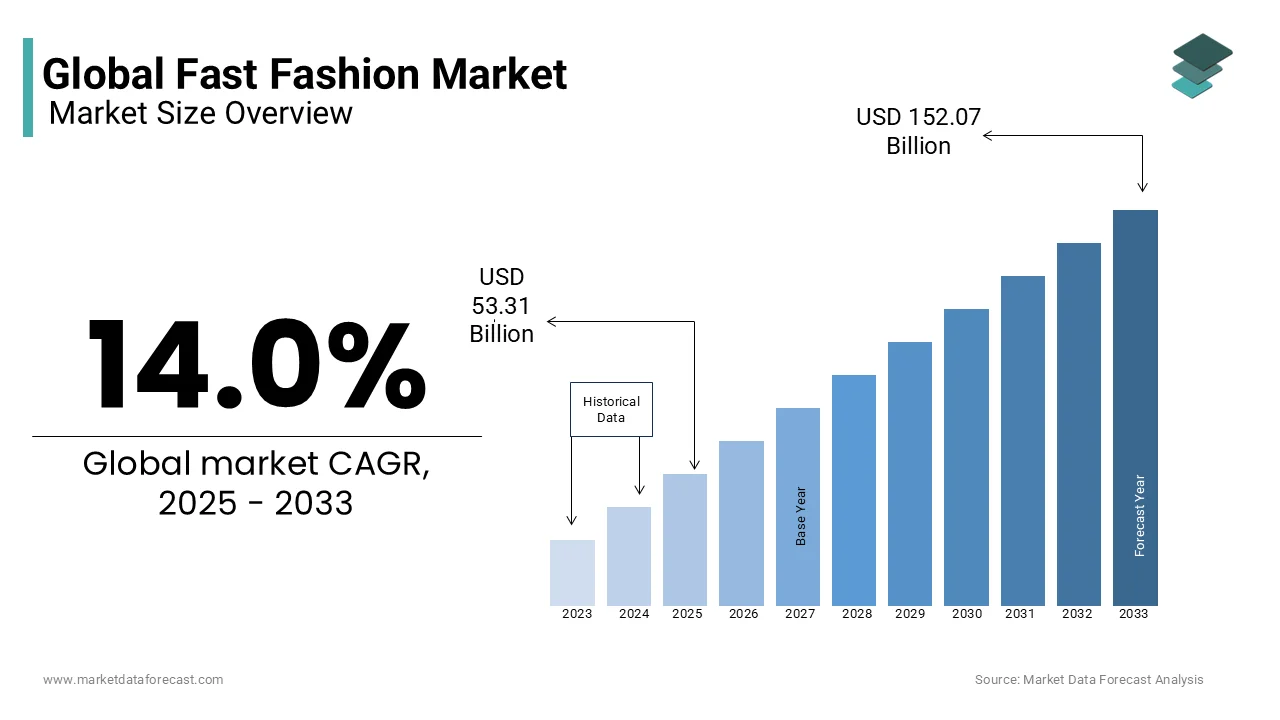Global Fast Fashion Market Size, Share, Trends & Growth Forecast Report - Segmented By Type (Adults Wear, Teens Wear, Kids Wear), Application, And Region (North America, Europe, APAC, Latin America, Middle East And Africa) – Industry Analysis From 2025 To 2033
Global Fast Fashion Market Size
The Global Fast Fashion market was valued at USD 46.76 billion in 2024. The global market size is expected to grow at a CAGR of 14.0% from 2025 to 2033 and be worth USD 152.07 billion by 2033 from USD 53.31 billion in 2025.
Fast fashion is the term that refers to the clothing industry. All the latest fashion trends can be available at affordable prices, which allows consumers to easily access fashion trends. The clothes worn by celebrities, or the style that showed up in the fashion week shows, are quickly moved to the retail stores at very low prices where common people who look for fashionable dressing styles can purchase them. These collections are highly fashionable, with new looks that attract a wide range of customers from many regions. Designers play an important role in designing replicas of high-fashion clothes and bringing them to the common people at extremely low prices.
Current Scenario of the Global Fast Fashion Market
The latest technological developments are a boom for fast fashion apparel. Manufacturing replicas of the new trend clothing styles with the latest technology has become very easy in today's world. Along with this, people's interest in customized or personalized clothing is attributed to leveraging the growth opportunities for the market in the coming years. Artificial intelligence and other technological developments in the clothing industry offer varied applications that increase the sales of fast fashion with personalized costumes. The launch of various products like sneakers and others according to the customer choice is greatly attracting consumers, especially in developed and emerging countries, which will certainly boost the market growth opportunities in the coming years. Collaboration between fast fashion retailers and luxury brand companies is another factor that is hugely influencing the market growth positively.
Frequently changing consumer choices towards fast fashion is acting as a big barrier for the key players. The textile, which was already designed and was not sold in any case, will create a huge loss for the company. Few companies clear the stocks by offering huge discounts on the products whereas leftover products will remain as textile waste and destroyed.
MARKET DRIVERS
The growing disposable income in both developed and developing countries is majorly fuelling the growth of the fast fashion market worldwide. In developing countries like India, the number of middle-class populations is rising at a random rate every year. According to the survey report, the middle-class population in India between 2021-2022 is 432 million, whereas the number is expected to reach 715 million by 2031. The survey report also stated that approximately 1.02 billion people will be in the middle-class economy by 2047, out of 1.66 billion people in India alone. 31% of middle-class populations were projected in 2020-2021, whereas it is estimated that nearly the middle-class population will reach 61% of the total population by 2047. These estimations are inclined to show positive results on the growth rate of the market in the coming period at a higher rate.
The rising popularity of trendy fashion clothes at inexpensive prices is another factor prompting the growth rate of the fast fashion market. Penetration of social media is one of the key factors in promoting all the latest fashion trends to target customers. Social media influencers play an important role in forwarding the latest fashion clothing to their followers, which enhances the designers to swiftly forward the replica products for sale. Many companies are gaining huge profits with the penetration of social media. Therefore, the demand for fast fashion clothing is increasing with social media influencers, which are bolstering the market growth rate simultaneously.
The rapid penetration of e-commerce in the fashion industry is supporting the fast fashion market growth. In addition to this, e-commerce platforms are granting various offers to both retailers and customers, enhancing the growth rate of the fast fashion market. E-commerce solutions for retailers have been very common in developed countries for many years, but since the emergence of the COVID-19 pandemic, the demand to shop online has surged across the world, boosting the share of the fast fashion market. Many companies that are using online shopping platforms are gaining much more profits through different channels. In recent years, the demand for online shopping has been growing at a potential rate that is linked to the surge in the growth rate of the fast fashion market. Fashion sales in e-commerce platforms are gaining attention from many customers across the world. Rising awareness over the availability of various fashion trends online with the launch of online shopping websites or applications that can be easily available on smartphones is attributed to gearing up the growth rate of the fast fashion market. Key market players like Shein, ASOS, and others are in first place with their ongoing sales through online websites. Shein was founded in 2008 in Cina. This fashion retailer has become popular with its unique collection of fashion clothes at affordable prices. Shein has become one of the top fashion retailers in 2022 across the world with its unique strategies to grow in the marketplace.
The popularity of fashion apparel is most common among the Gen Z population, where their choices for fast fashion apparel at minimum prices have brought fame for many online-based retailers, enhancing the growth rate of the fast fashion market. Nowadays, the lifecycle for clothes is becoming very short. The lifespan of clothes, even high-cost clothing, is very low, and the demand for the new collection is apparently prompting the market value from recent years. Frequent changes in consumer preferences towards clothing style and the launch of customizable designs according to their choices by retailers have become common strategies for companies, which account for fuelling the growth rate of the fast fashion market size. The rising number of working women populations is straightly propelling the growth rate of the market. Most working women prefer fast fashion apparel for office and daily wear. Their preference to buy inexpensive products with their earnings is accelerating the growth rate of the fast fashion market.
MARKET RESTRAINTS
The availability of branded clothing at affordable prices by top companies like Gap, Fast retailer Uniqlo, and others is hindering the growth of the fast fashion market. The huge competition between online retailers and private label retailers is posing a great challenge for the market. Environmental concerns and rising demand for organic-based clothing among consumers certainly limit the market value. The fabric used to make fast fashion clothes is relatively low quality, which is why the cost of these apparel is lower comparatively. Therefore, the low-quality clothing material and manufacturing procedures lead to the emission of carbon gases that are raising the concern of the higher authorities. Stringent rules and regulations by the government promote only environmentally friendly procedures that are inclined to show a negative impact on the market value during the forecast period. In addition, rising awareness among the public about using only eco-friendly products is a backlash for the key players that degrade the growth rate of the market. According to the UN Framework Convention on Climate Change, there is an increasing environmental concern in the textile industry. It is predicted that by 2030, the greenhouse emissions from the textile industry will rise up by 60%, which is becoming a huge concern for the market's key players in fast fashion.
REPORT COVERAGE
|
REPORT METRIC |
DETAILS |
|
Market Size Available |
2024 to 2033 |
|
Base Year |
2024 |
|
Forecast Period |
2025 to 2033 |
|
CAGR |
14.0% |
|
Segments Covered |
By Type, Application, And Region |
|
Various Analyses Covered |
Global, Regional and Country Level Analysis; Segment-Level Analysis; DROC; PESTLE Analysis; Porter’s Five Forces Analysis; Competitive Landscape; Analyst Overview of Investment Opportunities |
|
Regions Covered |
North America, Europe, APAC, Latin America, Middle East & Africa |
|
Market Leaders Profiled |
Zara (Inditex), H&M Group, Fast Retailing (Uniqlo), Gap, Forever 21, L Brands, Mango, Esprit, Primark and New Look |
SEGMENTAL ANALYSIS
By Type Insights
The adult wear segment is leading and has the dominant share of the market. The growing Gen Z population is one of the major factors that contribute to the growth rate of this segment. Adults' preference for new fashion styles that are available at cheap prices is accelerating the market growth. Kids' and teens' wear segment is likely to have the dominant growth rate throughout the forecast period.

By Application Insights
The women segment is gaining traction over the market share with the rising number of working-class people across the world. Working women prefer to wear highly fashioned outfits for the office, and their interest in affording low-quality fashionable clothes for a short period of time promotes the demand of the market. Men's segment is anticipated to have the dominant growth opportunities in the coming years.
REGIONAL ANALYSIS
The North American region holds a prominent share and is continuing to hold the same flow during the forecast period. Rising per capita income and growing focus on the launch of replicas of the daily fashion week styles at lower prices are pushing the market share towards positive. Increasing popularity to follow the latest trend is greatly influencing the growth rate of the market in North America. The US and Canada are the major countries contributing the highest share of the market. The US and Canada are the most developed countries in the world, and they have quickly adopted the latest technology in fashion brands. The launch of innovative technological advancement in fashion brands is the primary factor leveling up the market growth rate.

Asia Pacific is deemed to hit the highest CAGR by the end of 2033 with the rising population in emerging countries like India and China. The rising disposable income in these countries is esteemed to propel the growth rate of the fast fashion market. People in emerging countries seek the latest fashion apparel that is inexpensive, which is a common factor for the market to grow immensely. Along with this, consumer spending on clothing is widely increasing, with the rising expenditure on the fashion trend anticipated to surge the market growth rate in the Asia Pacific region.
Europe's fast fashion market is thriving and will have a significant share during the forecast period 2025-2033. Countries like the UK and Italy promote high-end fashion styles all the time. High disposable income and people's interest in the fashion field are dominantly fuelling the growth rate of the market in Europe. For instance, Zara, a Spanish company, announced that in 2023, sales hiked by 14.9% while profits rose by USD 5.7 billion. Therefore, the company is deemed to have escalated its investments with rapidly increasing sales. Latin America, and Middle East & Africa are expected to showcase steady growth opportunities throughout the forecast period.
KEY MARKET PLAYERS
Companies that are playing a major role in the global fast fashion market include Zara (Inditex), H&M Group, Fast Retailing (Uniqlo), Gap, Forever 21, L Brands, Mango, Esprit, Primark and New Look.
RECENT HAPPENINGS IN THE MARKET
- In 2023, Zara and H&M are inclined to take initiative steps towards the reduction of the messy carbon footprints. H&M started selling all the second-hand clothes in the UK with the tagline offer as "Ready to be loved again." In Germany and Sweden, H&M has already focused on selling these second-hand clothes online, which is gaining popularity.
MARKET SEGMENTATION
This research report on the global fast fashion market has been segmented and sub-segmented based on type, application, and region.
By Type
- Adults Wear
- Teens Wear
- Kids Wear
By Application
- Men
- Women
- Children
By Region
- North America
- Europe
- Asia Pacific
- Latin America
- Middle East and Africa
Frequently Asked Questions
1. What factors are driving the growth of the fast fashion market?
The fast fashion market is experiencing significant growth due to several factors including changing consumer preferences towards affordable and trendy clothing, advancements in technology allowing for quicker production cycles, and the rise of e-commerce platforms enabling easy access to fast fashion brands.
2. What are some sustainable practices being adopted by fast fashion brands?
Some fast fashion brands are implementing sustainable practices such as using eco-friendly materials, reducing waste through recycling and upcycling initiatives, and improving supply chain transparency. Additionally, some brands are focusing on creating timeless pieces that are designed to last longer and transcend seasonal trends.
3. What is the future outlook for the fast fashion market?
The future of the fast fashion market is likely to be shaped by increasing consumer demand for sustainability and ethical practices. Fast fashion brands will need to adapt to these changing preferences by implementing more sustainable business models, embracing innovation, and fostering transparency throughout their supply chains.
Related Reports
Access the study in MULTIPLE FORMATS
Purchase options starting from
$ 2500
Didn’t find what you’re looking for?
TALK TO OUR ANALYST TEAM
Need something within your budget?
NO WORRIES! WE GOT YOU COVERED!
Call us on: +1 888 702 9696 (U.S Toll Free)
Write to us: sales@marketdataforecast.com
